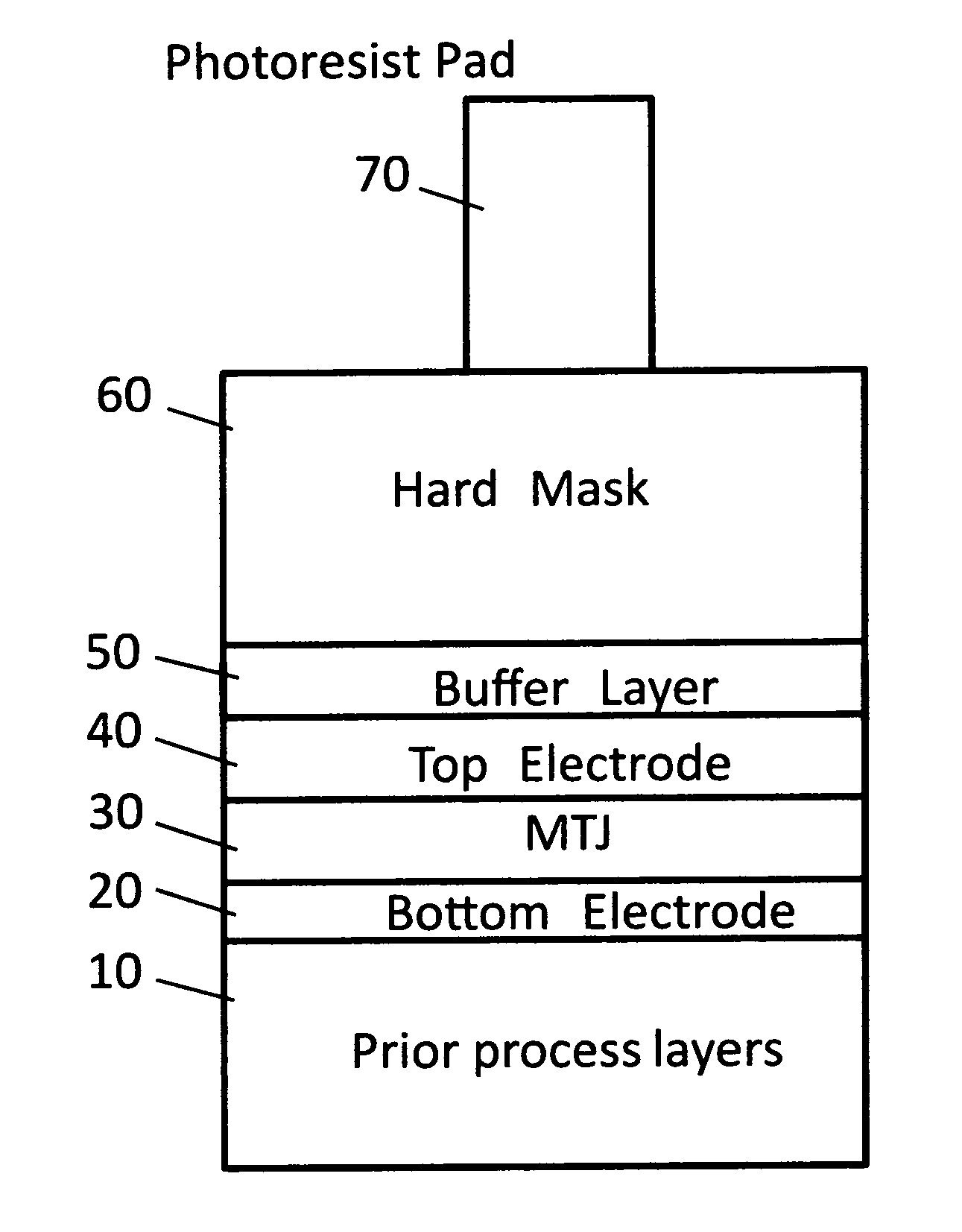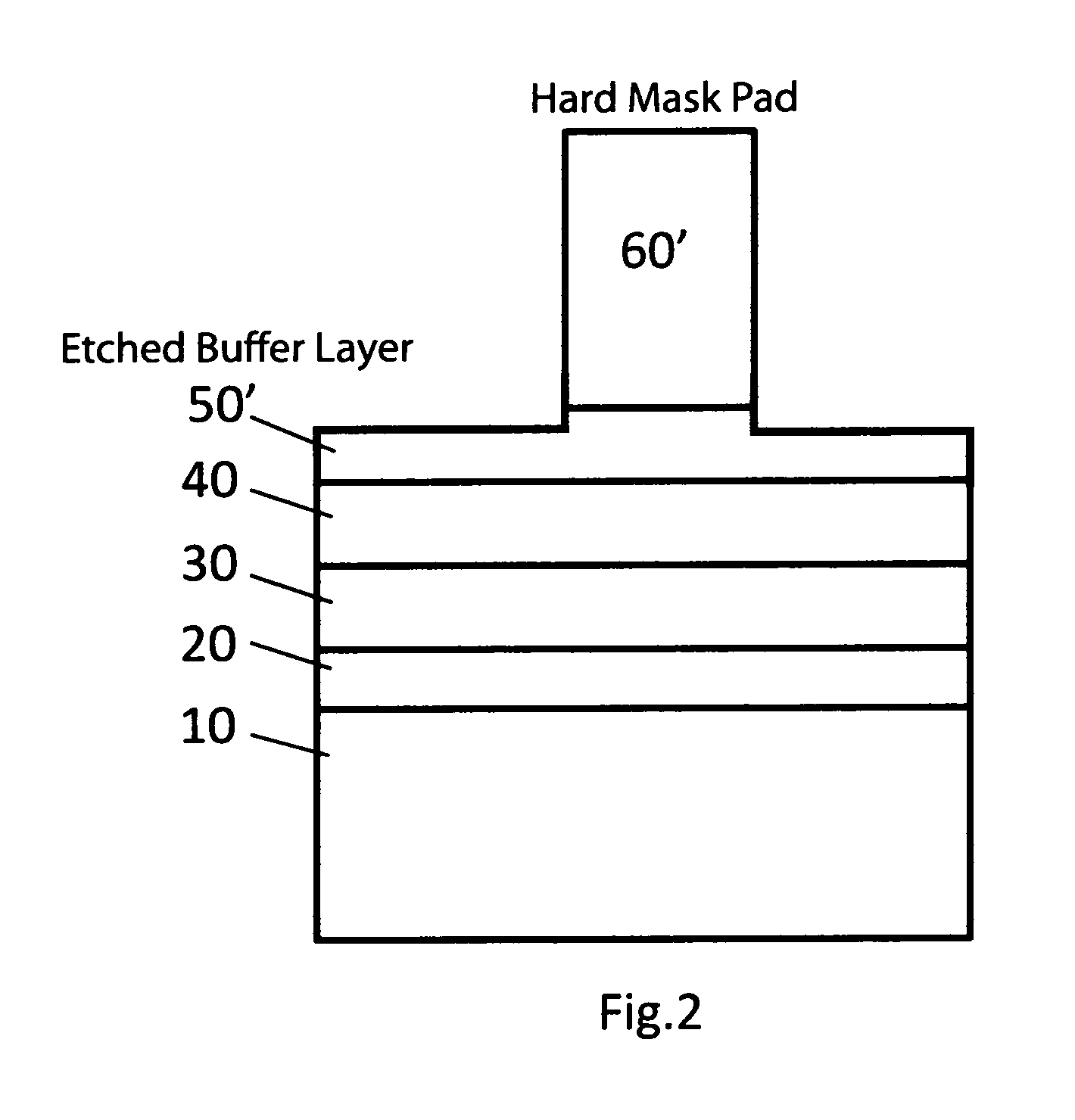Mram etching processes
a technology of etching process and memory element, which is applied in the manufacture/treatment of electrical apparatus, semiconductor devices, and galvano-magnetic devices. it can solve the problems of slow etching, generate uniformity problems, and passivation of the surface of the top electrode by the hard mask etchant, and achieve low etching rate, good selectivity, and high selectivity.
- Summary
- Abstract
- Description
- Claims
- Application Information
AI Technical Summary
Benefits of technology
Problems solved by technology
Method used
Image
Examples
first embodiment
[0025]FIG. 1 and FIG. 2 will be used to describe the first embodiment of the invention. As shown in cross section in FIG. 1, the fabrication process has previously deposited the various thin film layers shown, and a photoresist pad 70 which typically include a bottom antireflective coating (BARC) polymer layer, has been patterned over the selected area. As shown in FIG. 1, a bottom electrode layer 20, an MTJ layer stack 30, a top electrode layer 40, a hard mask buffer layer 50 and a hard mask layer 60 are deposited sequentially. In this embodiment hard mask buffer layer 50 is inserted between a hard mask 60 and top electrode layer 40 to prevent the top electrode surface from being exposed to the etching ambient used to etch the hard mask. To reduce processing steps, the material for buffer layer 50 is selected so that it can be removed by top electrode etching ambient. The preferred materials for the buffer layer 50 are silicon nitride, silicon carbide and their substitutes. A conve...
second embodiment
[0028]FIGS. 3 and 4 illustrate cross sectional views of layers at selected stages of a fabrication process of an MTJ cell according to the second embodiment of the invention. A layer stack structure of the second embodiment is shown in FIG. 3 prior to etching. As in the first embodiment there are two etching processes in this embodiment: a first etch to pattern the hard mask pads and a second etch to pattern the top electrode. Each of these etch processes uses a different etching ambient.
[0029]The bottom electrode layer 20, which is deposited over prior process layers 10, is followed by the MTJ layer stack 30, the top electrode layer 40, a first hard mask layer 60A and a second hard mask layer 61. A conventional hard mask layer material such as silicon oxide, silicon nitride, titanium nitride and their substitutes is selected for the first hard mask layer 60A. The second hard mask layer 61 is preferably a material having a low etching rate in the hard mask and / or top electrode etchi...
third embodiment
[0032]In the third embodiment, the top electrode structure includes two layers: a first top electrode layer 41 of Cu is deposited on the MTJ 30 before the second top electrode layer 40 of a selected metal as shown in FIG. 6. The second top electrode layer 40 can be tantalum (Ta). Using the Ta / Cu embodiment compensates for high etch rate of Cu in MTJ etching ambient. The total top electrode thickness is increased to widen a process window of interconnection process. A photolithography process as described above creates a photoresist pad (not shown) which is followed by etching the second hard mask 61, etching the second top electrode layer 40, etching the first top electrode (Cu) layer 41, etching MTJ 30 and etching half way through the thickness of bottom electrode 20 as shown in FIG. 7. As an option, passivation layer 70 may be deposited to prevent MTJ from oxidation as shown in FIG. 8. From either the stage of FIG. 7 or 8, the standard bottom electrode etching process follows.
PUM
 Login to View More
Login to View More Abstract
Description
Claims
Application Information
 Login to View More
Login to View More - R&D
- Intellectual Property
- Life Sciences
- Materials
- Tech Scout
- Unparalleled Data Quality
- Higher Quality Content
- 60% Fewer Hallucinations
Browse by: Latest US Patents, China's latest patents, Technical Efficacy Thesaurus, Application Domain, Technology Topic, Popular Technical Reports.
© 2025 PatSnap. All rights reserved.Legal|Privacy policy|Modern Slavery Act Transparency Statement|Sitemap|About US| Contact US: help@patsnap.com



